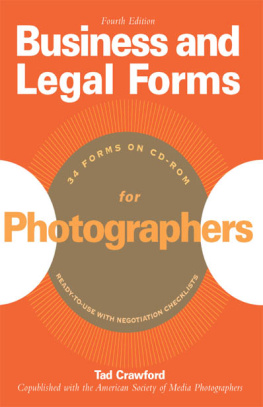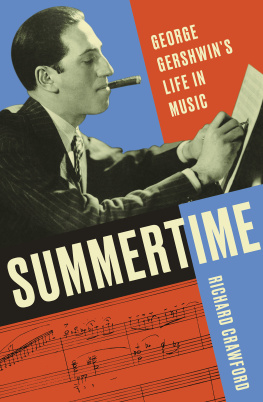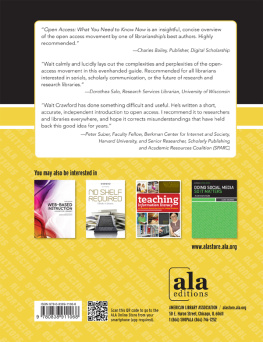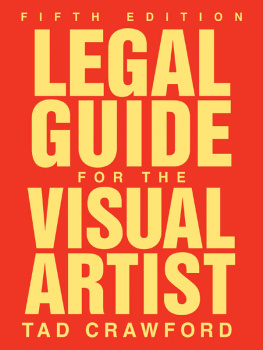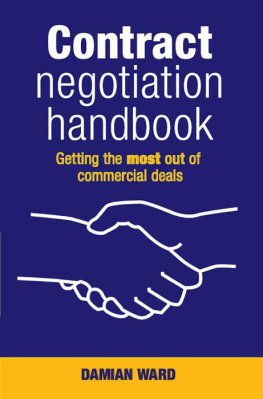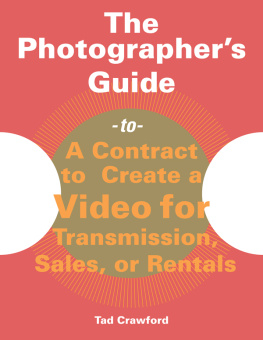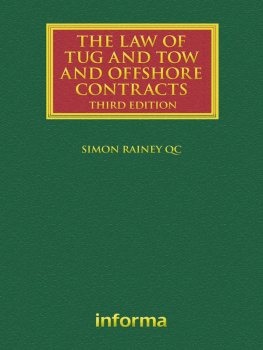Crawford - Business and Legal Forms for Photographers
Here you can read online Crawford - Business and Legal Forms for Photographers full text of the book (entire story) in english for free. Download pdf and epub, get meaning, cover and reviews about this ebook. City: United States, year: 2015, publisher: Allworth Press : American Society of Media Photographers, genre: Home and family. Description of the work, (preface) as well as reviews are available. Best literature library LitArk.com created for fans of good reading and offers a wide selection of genres:
Romance novel
Science fiction
Adventure
Detective
Science
History
Home and family
Prose
Art
Politics
Computer
Non-fiction
Religion
Business
Children
Humor
Choose a favorite category and find really read worthwhile books. Enjoy immersion in the world of imagination, feel the emotions of the characters or learn something new for yourself, make an fascinating discovery.
- Book:Business and Legal Forms for Photographers
- Author:
- Publisher:Allworth Press : American Society of Media Photographers
- Genre:
- Year:2015
- City:United States
- Rating:4 / 5
- Favourites:Add to favourites
- Your mark:
- 80
- 1
- 2
- 3
- 4
- 5
Business and Legal Forms for Photographers: summary, description and annotation
We offer to read an annotation, description, summary or preface (depends on what the author of the book "Business and Legal Forms for Photographers" wrote himself). If you haven't found the necessary information about the book — write in the comments, we will try to find it.
Business and Legal Forms for Photographers — read online for free the complete book (whole text) full work
Below is the text of the book, divided by pages. System saving the place of the last page read, allows you to conveniently read the book "Business and Legal Forms for Photographers" online for free, without having to search again every time where you left off. Put a bookmark, and you can go to the page where you finished reading at any time.
Font size:
Interval:
Bookmark:

Legal Forms
for
Photographers
Tad Crawford
Fourth Edition

1991, 1997, 1999, 2002, 2007, 2010 by Tad Crawford
All rights reserved. Copyright under Berne Copyright Convention, Universal Copyright Convention, and Pan-American Copyright Convention. No part of this book, including the forms in electronic format on the accompanying CD-ROM, may be reproduced, stored in a retrieval system, or transmitted in any form, or by any means, electronic, mechanical, photocopying, recording, or otherwise, without prior permission of the publisher. Notwithstanding the foregoing, photographers may reproduce any form in this book without charge for the limited purpose of use in their business.
14 13 12 11 10 5 4 3 2 1
Published by Allworth Press, an imprint of Allworth Communications, Inc.,
10 East 23rd Street, New York, NY 10010.
Book design: Douglas Design Associates, New York
Cover design: Derek Bacchus
LIBRARY OF CONGRESS CATALOGING-IN-PUBLICATION DATA:
Business and legal forms for photographers.4th ed.
p. cm.
ISBN 978-1-58115-669-0
eBook ISBN 978-1-58115-735-2
1. PhotographyLaw and legislationUnited StatesForms.
2. CopyrightPhotographsUnited StatesForms. 3. Artists contracts
United StatesForms.
KF2042.P45C73 2010
343.7307877dc22 2009033004
Printed in Canada
This book is designed to provide accurate and authoritative information with respect to the subject matter covered. It is sold with the understanding that the publisher is not engaged in rendering legal or other professional services. If legal advice or other expert assistance is required, the services of a competent attorney or professional person should be sought. While every attempt is made to provide accurate information, the author or publisher cannot be held accountable for errors or omissions.
A ttaining the knowledge of good business practices and implementing their use is an important step toward success for any professional, including the professional photographer. The forms contained in this book deal with the most important business transactions that any photographer is likely to undertake. A CD-ROM is also included to make customization easier. The fact that the forms are designed for use and that they favor the photographer give them a unique value.
Understanding the business concepts behind the forms is as important as using them. By knowing why a certain provision has been included and what it accomplishes, the photographer is able to negotiate when faced with someone elses business form. The photographer knows what is and is not desirable. The negotiation checklists offer a map for the negotiation.
All forms, whether the photographers or someone elses, can be changed. Before using these forms, the photographer should consider reviewing them with his or her attorney. This provides the opportunity to learn whether local or state laws make it wise to modify any of the provisions. For example, would it be best to include a provision for arbitration of disputes, or are the local courts speedy and inexpensive, making an arbitration provision unnecessary?
The forms must be filled out, which means that the blanks in each form must be completed. Beyond this, however, the photographer can always delete or add provisions on any form. Deletions or additions to a form are usually initialed in the margin by both parties. It is also a good practice to have each party initial each page of the contract, except the page on which the parties sign.
The photographer must ascertain that the person signing the contract has authority to do so. If the photographer is dealing with a company, the companys name should be included, as well as the name of the individual authorized to sign the contract and the title of that individual. If it isnt clear who will sign or if that person has no title, the words Authorized Signatory can be used instead of a title.
If the photographer will not be meeting with the other party to sign the contract, it would be wise to have that party sign the forms first. After the photographer gets back the two copies of the form, they can be signed and one copy returned to the other party. As discussed in more detail under letter contracts, this has the advantage of not leaving it up to the other party to decide whether to sign and thus make a binding contract.
If additional provisions that wont fit on the contract forms should be added, simply include a provision stating, This contract is subject to the provisions of the rider attached hereto and made a part hereof. The rider is simply another piece of paper which would be headed, Rider to the contract between ______________________ and ___________________, dated the _______ day of ______, 20____. The additional provisions are put on this sheet and both parties sign it.
Most of the forms in this book are contracts. A contract is an agreement that creates legally enforceable obligations between two or more parties. In making a contract, each party gives something of value to the other party. This mutual giving of value is called the exchange of consideration. Consideration can take many forms, including the giving of money or a photograph or the promise to create a photograph or pay for a photograph in the future.
Contracts require negotiation. The forms in this book are favorable to the photographer, so changes may very well be requested. This books explanation of the use of each form should help the photographer evaluate changes which either party may want to make in any of the forms. The negotiation checklists should also clarify what changes would be desirable in forms presented to the photographer.
Keep in mind that negotiation need not be adversarial. Certainly the photographer and the other party may disagree on some points, but the basic transaction is something that both want. This larger framework of agreement must be kept in mind at all times when negotiating. Of course, the photographer must also know which points are nonnegotiable and be prepared to walk away from a deal if satisfaction cannot be had on these points.
When both parties have something valuable to offer each other, it should be possible for each side to come away from the negotiation feeling that they have won. Win-win negotiation requires each side to make certain that the basic needs of both are met so that the result is fair. The photographer cannot negotiate for the other side, but a wise negotiation strategy must allow the other side to meet their vital needs within a larger context that also allows the photographer to obtain what he or she must have.
It is a necessity to evaluate negotiating goals and strategy before conducting any negotiations. The photographer should write down what must be achieved and what can be conceded or modified. The photographer should try to imagine how the shape of the contract will affect the future business relationship with the other party. Will it probably lead to success for both sides and more business or will it fail to achieve what one side or the other desires?
When negotiating, the photographer should keep written notes close at hand concerning goals and strategy. Notes should be kept on the negotiations, too, since many conversations may be necessary before final agreement is reached. At certain points the photographer should compare what the negotiations are achieving with the original goals. This will help evaluate whether the photographer is conducting the negotiations according to plan.
Next pageFont size:
Interval:
Bookmark:
Similar books «Business and Legal Forms for Photographers»
Look at similar books to Business and Legal Forms for Photographers. We have selected literature similar in name and meaning in the hope of providing readers with more options to find new, interesting, not yet read works.
Discussion, reviews of the book Business and Legal Forms for Photographers and just readers' own opinions. Leave your comments, write what you think about the work, its meaning or the main characters. Specify what exactly you liked and what you didn't like, and why you think so.

